|
|
Often we hear about endangered species—animals or plants on the edge of extinction—however we rarely hear about endangered environments—entire ecosystems that may disappear from Earth due to humankind’s growing footprint. Tropical dry forests are just such an ecosystem: with only 2 percent of the world’s tropical dry forest remaining it is one of the world’s most endangered ecosystems.
A newly established organization, the Azuero Earth Project, is working not only to preserve some of the world’s last tropical dry forest on the Azuero peninsula in Panama, but also to begin restoration projects hoping to aid both the forest’s viability and the local people. The Azuero peninsula lies 250 kilometers west of Panama City.
Edwina von Gal, a landscape designer, is one of the founders of the Azuero Earth Project, as well as president of the organization. She describes the mission of the project as “to make the Azuero a safe place to live for all species”, in other words the Azuero Earth Project wants to conserve and restore forest while at the same time helping local farmers and ranchers learn sustainable practices.
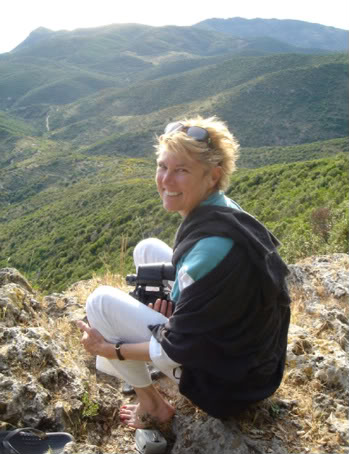 Edwina von Gal, president of Azuero Earth Project. Photo courtesy of Azuero Earth Project. |
In the process, the Azuero Earth Project is working on saving the Critically Endangered Azuero spider monkey, endemic to the region, and the Endangered great green macaw.
“We are just applying for a grant to do a spider monkey census. There is so little known about them, but the best information suggests that there may be fewer than 100 left,” von Gal says. “We are looking now at collecting accurate information (and some photos) to use for priority ranking of forest parcels. The great green macaw, as mentioned above, is also threatened. The macaw has a greater threat from poaching (for pets) than the monkey, but both share similar habitats so we are looking at them somewhat together.”
With some of the top tropical research centers in the world, Panama has a wealth of scientists and conservationists at the cutting edge of their field, whose help the Azuero Earth Project has enlisted.
“They are why we are there and provide us with the foundation for what we are doing,” says von Gal.
Reflecting new ideas in conservation and sustainability, Azuero Earth Project wants not only to protect the tropical dry forest and its biodiversity, but also work with integrating humans more fully with nature.
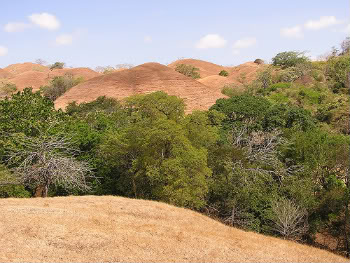 Tropical dry forest fragment in typical Azuero penninsula landscape. Photo courtesy of Azuero Earth Project. |
“Mankind has not really figured out what our role is in living with nature,” von Gal explains. “So far the only way we know to protect nature from us is to put it aside, so part of the world is US and the other part is THEM, i.e. nature, like a big zoo. That is not a viable, sustainable solution.”
The local community so far has proven open-minded. “The farmers can see that their land is wearing out, and their wells are faltering,” von Gal says. “They are worried about chemicals. They are interested: it just has to work logistically and financially.”
Von Gal hopes that the Azuero Earth Project by employing the latest technologies, partnering with other NGOs, working with some of the world’s best and brightest conservationists, and utilizing new models and ideas about sustainability, can become a model for future projects in the tropics and beyond.
BACKGROUND
Mongabay: What is your background?
Edwina von Gal: I am a landscape designer who has become increasingly involved in environmentally oriented projects.
Mongabay: What led you to establish the Azuero Earth Project?
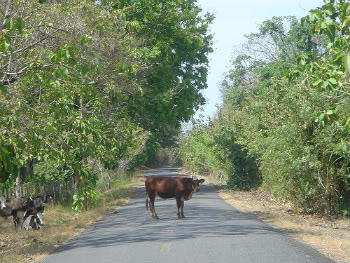 Cattle provide one of the major livelihoods for locals in the region, but present dangers to the ecosystem. Photo courtesy of Azuero Earth Project. |
Edwina von Gal: I came to Panama in 2002 when I was hired by Frank Gehry to design the park for the Biodiversity museum www.biomuseopanama.org ; I needed to learn about native trees, and the Smithsonian Tropical Research Institute (STRI) was made the science advisory team, (heaven!) so I began to meet people and eventually went out to the Azuero to visit a reforestation plot. I ended up returning and buying land there and a small group of us decided to try and do something about the fact that the land was increasingly nonproductive for the local farmers and that the work that PRORENA (native species reforestation project, part of STRI and Center for Tropical Forest Systems or CTFS) was doing could change this. We decided to try and make it happen.
Mongabay: What is the goal of Azuero Earth Project?
Edwina von Gal: To make the Azuero a safe place to live for all species.
THE TROPICAL DRY FOREST
Mongabay: What are the unique attributes of tropical dry forest?
Edwina von Gal: The seasonal tropical dry forest has over a meter of rain but also a prolonged dry period of at least 3-4 months during which it rains little or not at all and many of the trees (broadleafs) lose their leaves. In much of the Azuero we get about 1.5m of rain per year but none at all from early January to late April. Really, absolutely none. Plus the winds are strong and hot so things get very dry. Fires are a concern. They are not part of the dry forest ecosystem and do not occur naturally (no lightning) but when farmers are burning off their fields it can spread. In order to protect areas of reforestation or natural succession it is important to cut wide fire breaks and work with the neighbors who are burning to have fire fighting teams at the ready. Once trees get a bit larger and the canopy closes, the shade will inhibit growth of combustible undergrowth, and/or cows can be returned to the land to keep the undergrowth down and provide supplemental income. PRORENA, among others, has been doing test plot and on farm trials, studying the huge number of variables that can affect the success of these methods.
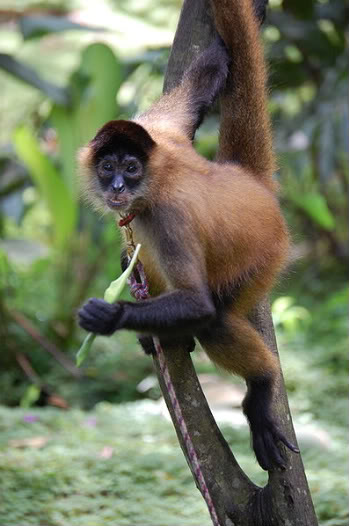 The Critically-Endangered Azuero spider monkey. Photo by Steven G. Johnson. |
Mongabay: Only 2 percent of the earth’s tropical dry forest remain, why do you think so much has been lost?
Edwina von Gal: Most of tropical civilization lives in what once was dry forest. The dry forest climate is healthier than rain forest, is easier to clear, and generally has better soils. I think of it as a sort of ghost forest, no one thinks, when in a town or city, about what was there before. Because of this, dry forests are small and have not received the kind of preservation attention that rain forests have received, yet they are highly rich in biodiversity and far closer to extinction.
Mongabay: What is the state of the forest on the Azuero peninsula?
Edwina von Gal: Very little left. Most of the forest exists in small remnant patches that were not worth cutting for cattle, or along streams where cattle could go for shade and water. Of course this is terrible for the watershed. And even the remnant patches have been logged so many of the valuable species are not there to provide seed stock for spontaneous succession. There are some protected areas and one national park (Cerro Hoya) which we are working to protect and connect to the forest remnants in order to give the stranded species access to a larger genetic pool. Princeton University is just beginning a big study with us to map all the remnant patches and analyze them for their composition and health and predict their future. It is a wonderfully interesting application of computer technology (analyzing hi resolution pixels and comparing them with known quantities) but will, of course, be supported by ground truthing. We are going to combine this work with a Spider Monkey census and are working with Fundacion Avifauna in their Great Green Macaw census. We have chosen these two animals because they are key indicators of habitat health and also very charismatic, so it is easier to engage support.
Mongabay: What methods are you employing to reforest and reinvigorate the landscape?
Edwina von Gal: That’s a long story and may never end. See the scientific papers on our website for research to date, plus we have a number of ongoing experiments (both scientific and informal) on our own properties and with clients and friends. We are supporting a local nurseryman who is propagating native trees and encouraging locals and foreigners alike to plant them in favor of exotics. Next we will be looking to various new financial structures (like carbon and avoided deforestation) to help support farmers to make the switch to these more sustainable farming possibilities. We will continue to give them technical companionship, which has proven (see Eva Garen, et al) to be critical to the success of new methods.
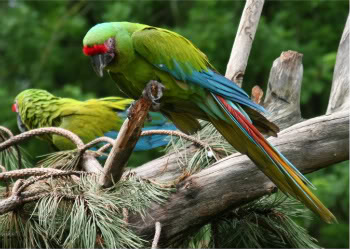 The Endangered great green macaw, pictured here in captivity, can still be found on the Azuero penninsula. Photo by Alois Staudacher. |
Mongabay: Your mascot is the Azuero spider monkey, can you tell us about this critically endangered species? Are there other endemic or endangered species in the region?
Edwina von Gal: We are just applying for a grant to do a Spider Monkey census. There is so little known about them, but the best information suggests that there may be fewer than 100 left. We are looking now to collecting accurate information (and some photos) to use for priority ranking of forest parcels. The Great Green Macaw, as mentioned above, is also threatened. The macaw has a greater threat from poaching (for pets) than the monkey, but both share similar habitats so we are looking at them somewhat together. There are some big cats left on the Azuero, (not my field, I can’t say exactly which) that are greatly prized by hunters. The populations of animals like sloths and agoutis, which are relatively common in other parts of Panama, have been seriously reduced. There just isn’t enough habitat to give them food or cover from a very enthusiastic hunting community.
In Cerro Hoya, the small amount of botanical work that has been done there leads us to believe there are a number of endemic tree species of unknown origin. Because it is much older than the rest of the Isthmus (it drifted in from west) and is a higher wetter forest, surrounded by dry, it is prime for the occurrence of endemics. We are working with Scott Mori of the New York Botanical Garden to mount some serious survey work starting this coming fall. Depending on funding, we shall see how long it takes. Hopefully we will be able to increase the amount of protection that the forest needs to stop the logging, poaching and clearing that is slowly eroding it from all sides.
WORKING WITH THE COMMUNITY
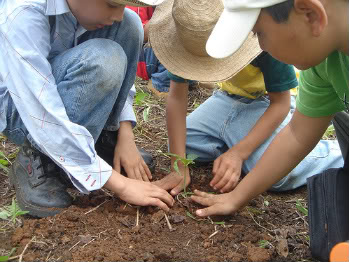 Children planting trees on the Azuero penninsula. Photo courtesy of Azuero Earth Project. |
Mongabay: How has the response been from local landowners to working with you organization?
Edwina von Gal: So far, very good. Our work in the community has to date been small and quite personal, working with those who are interested and willing, so I don’t know that it is altogether a representative sample. However, the farmers can see that their land is wearing out, and their wells are faltering. They are worried about chemicals. They are interested: it just has to work logistically and financially. They are cattlemen deep in their bones; we can’t afford to forget that.
Mongabay: What role does education play in changing local people’s minds about the need to protect (and in some cases reforest) the Azuero region?
Edwina von Gal: Absolutely essential. The next generation will be the ones who decide the fate of so much. Maybe even before that if the current government continues to be so blind. We are fighting urban flight in an area that is considered the cultural center of the country. This is exacerbated by the influx of tourism which I don’t see as positive in any way. I have become very skeptical about the possibility that ecotourism can really be a benefit to the local people, at least not with the way things are structured there now. Sustainable development is an oxymoron.
Mongabay: Panama has a wealth of scientists stationed in the country, how does this affect Azuero Earth Project?
Edwina von Gal: They are why we are there and provide us with the foundation for what we are doing, which is to find ways and means to apply the knowledge to make beneficial changes.
Mongabay: How do you balance economic needs with environmental needs in the community?
Edwina von Gal: That is an ever present challenge. We don’t have great answers, it will take government money and international funding to overcome the transitional economic troughs that farmers face when converting to agroforestry or silvo pastoral. In spite of the fact that one might know it is better, it has to be within their reach.
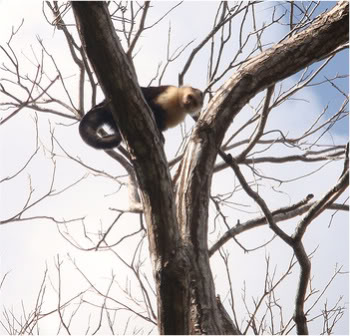 Capuchin monkey in the tropical dry froest. Photo courtesy of Azuero Earth Project. |
Mongabay: What was the organization’s greatest success so far and its greatest challenge?
Edwina von Gal: I think we are most proud of the collaborations that have formed around our programs. We have a number of educational institutions that are bringing students down to work on their own curriculum as well as take on projects that we suggest so they can contribute to what we are doing from their classrooms. The Princeton study is an outgrowth of one such student visit. Now it has gotten to be quite a large project which will include the local community. Our relationships with other NGO’s is also critical. It seems to be legendary that NGO’s are competitive and insular. We are trying to be exactly the opposite and so far, our joint projects with The World Land Trust, AviFauna, EarthTrain, etc attest to the possibilities. We are a young organization and carefully laying the ground work for building strong effective programs. The biggest challenge that we wish to overcome is the history of promises not kept. So many organizations come with great dreams and then are never seen again. We are trying to build our dreams on solid foundations of science, community and funding.
Mongabay: How can people who live outside the Azuero region help?
Edwina von Gal: Well, donations are most welcome. For the moment, I could use help with the website (see below), and we are doing a job search for a director, so interested applicants welcome to request a job description. Post docs are welcome to inquire about research opportunities and educational institutions can arrange student/faculty visits. We will have interesting volunteer opportunities in Panama once we get our office in Pedasi built and staffed.
NEW IDEAS AND TECHNOLOGY
Mongabay: What are some of the cutting-edge projects that you are working on?
 “I think of it as a sort of ghost forest, no one thinks, when in a town or city, about what was there before,” von Gal says about the endangered tropical dry forest. Photo courtesy of Azuero Earth Project. |
Edwina von Gal: We are experimenting with concepts that we think will be relevant to everyone everywhere to explore the ways that humans can become better integrated into the earth’s ecosystems. Our guest expert program will continue to investigate a wide range of topics (architecture, storm and waste water, garbage) that are critical to our making essential changes. We will share our success and failures on the website. The use of the internet as a vital element of our work is also maybe worth noting. The website is, in and of itself, one of our programs. We hope that it will contain information that is relevant to the local communities (Spanish version coming soon) as well as readers everywhere. Combined with the concept of the Red Verde (totally integrated biodiversity planning), we hope we can create successful programs that are relevant and good models for the rest of Panama, Central America, and the tropics.
Mongabay: What do you mean by ‘totally integrated biodiversity planning’?
Edwina von Gal: Mankind has not really figured out what our role is in living with nature. So far the only way we know to protect nature from us is to put it aside, so part of the world is US and the other part is THEM, ie nature, like a big zoo. That is not a viable, sustainable solution. It also lacks imagination, intelligence and fun. The basis for the thinking is represented by the field of Restoration Ecology. One of the basic books on the subject is The Sunflower Forest by William Jordan.
Mongabay: What role has technology played in your organization far?
Edwina von Gal: Technology has played a big role that is still wide open to new developments. We originally did not think that we would be able to use the internet to reach local populations but now many of the schools in the area are incorporating computers in their classrooms and most towns have an internet café.
The mapping project is highly technical as they will be analyzing pixels and comparing them with other forest types to project the way the land will respond to different conditions and rank parcels for best use practices.
We plan to employ computer models to design the most efficient passively cooled buildings, sophisticated data bases to compile and share the “Flowering Plants of the Azuero” project.
Mongabay: How could the models and concepts your organization is developing be applied elsewhere? Could they be useful throughout the tropics? What about other ecosystems?
Edwina von Gal: Yes, they are relevant to the entire world. The principals of Restoration Ecology can (and really ought to) be applied in any ecosystem by anyone. Our work will be specifically about the Azuero, and more easily translated into other projects in the tropics, especially the Dry Forest. But our successes and failures will resonate with the entire world of people trying to do the same thing. Our online resource center will make that possible.
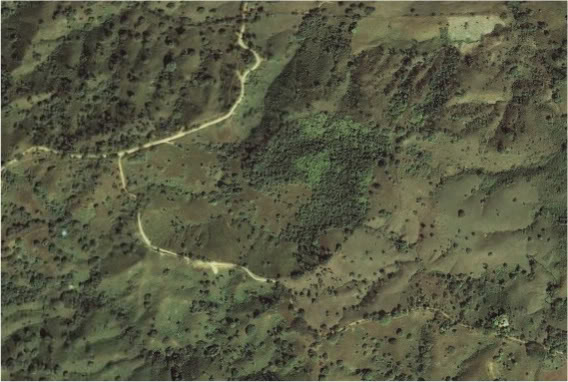
Google Earth snapshot of a characteristic piece of the Azuero penninsula: agriculture and grazing lands mixed with fragmented forests.
Related articles
Conservation through commerce in Costa Rica

(05/25/2009) While Costa Rica is lauded for its conservation ethic, environmental concerns remain in the country. Overdevelopment is tied to many issues, including pollution, degradation of ecosystems, deforestation, and soil erosion, while unsustainable fishing plagues coastal waters. Costa Rica’s wildlife is also directly affected by hunting as crop and livestock pests, predation and displacement by introduced species, and the illegal pet trade.
Costa Rica protects green macaw by banning logging of mountain almond tree
(10/27/2008) Costa Rica's high court has prohibited the cutting of a certain species of tree, in part because a highly endangered type of parrot uses the tree almost exclusively for nesting.
Mexican canyon serves as key refuge for endangered spider monkeys
(06/09/2008) A picturesque canyon in Chiapas, Mexico is serving as an important refuge for the northernmost population of Spider monkeys, reports a study published in the June issue of Tropical conservation Science.
Cache of rare and undiscovered species under threat in Panama
(04/21/2008) Rare and previously undiscovered species are under threat by loggers, ranchers, and poachers in an isolated patch of cloud forest in Panama, a prominent group of scientists has warned. The group, the Association for Tropical Biology and conservation (ATBC), has called on the Panamanian government to immediately provide protected-area status to the region.
(03/30/2008) Half a century after most of Costa Rica’s rainforests were cut down, researchers from the Boyce Thompson Institute took on a project that many thought was impossible – restoring a tropical rainforest ecosystem.
Large-scale agriculture ‘compromises’ forest’s ability to recover
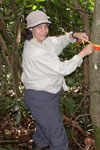
(11/19/2007) As deforestation of tropical forests continues unhindered, one of the future hopes for these damaged ecosystems is regeneration in secondary forests. Some areas that were once slash-and-burned for cattle ranching or subsistence agriculture have been abandoned, allowing scientists to study the possibility of recovery in the rainforest. If anyone has a clear idea of the potential of secondary forests it is Robin L. Chazdon. Dr. Chazdon, a full professor of Ecology and Evolutionary Biology at the University of Connecticut, has been studying the regeneration of secondary forest for over twenty-five years. She has published over 50 papers on tropical ecology, currently she serves as an active member of the Biotropica editorial board and is a member of the Bosques Project, which measures secondary forest recovery in Northern Costa Rica.